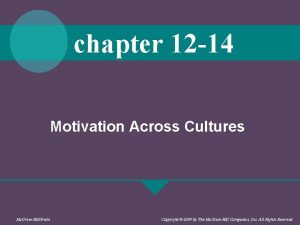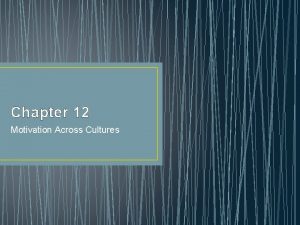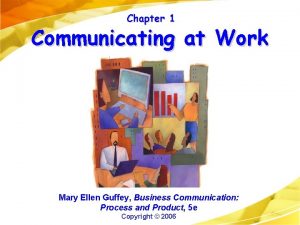Chapter 4 Communicating Across Cultures Mary Ellen Guffey














- Slides: 14

Chapter 4 Communicating Across Cultures Mary Ellen Guffey, Business Communication: Process and Product, 5 e Copyright © 2006

Increasing Importance of Intercultural Communication • Technological advancements • General global interconnectivity • Globalization of markets • Intercultural workforce Mary Ellen Guffey, Business Communication: Process and Product, 5 e Ch. 4, Slide 2

Understanding Culture How is culture like a computer program? Society, gender, race, age, religion, and other factors control our reactions and behavior. Mary Ellen Guffey, Business Communication: Process and Product, 5 e Ch. 4, Slide 3

Characteristics of Culture 1. Culture is learned. 2. Cultures are inherently logical. 3. Culture forms our self-identity and community. 4. Culture combines the visible and the invisible. 5. Culture is dynamic. Mary Ellen Guffey, Business Communication: Process and Product, 5 e Ch. 4, Slide 4

Improving Communication With Intercultural Audiences Oral Messages • Learn foreign phrases. • Use simple English. • Speak slowly and enunciate clearly. • Observe eye messages. • Encourage accurate feedback. • Check frequently for comprehension. Mary Ellen Guffey, Business Communication: Process and Product, 5 e Ch. 4, Slide 5

Improving Communication With Intercultural Audiences Oral Messages • Accept blame. • Listen without interrupting. • Tell speakers if you don’t understand. • Remember to smile! • Follow up in writing. Mary Ellen Guffey, Business Communication: Process and Product, 5 e Ch. 4, Slide 6

Improving Communication With Intercultural Audiences Written Messages • Adapt to local formats. • Use short sentences and short paragraphs. • Avoid ambiguous expressions. • Strive for clarity. • Use correct grammar. Mary Ellen Guffey, Business Communication: Process and Product, 5 e Ch. 4, Slide 7

Improving Communication With Intercultural Audiences Written Messages • Cite numbers carefully. • Accommodate reader in organization, tone, and style. Mary Ellen Guffey, Business Communication: Process and Product, 5 e Ch. 4, Slide 8

Making Ethical Decisions Across Borders • • Broaden your view of other cultures. Avoid reflex judgments. Find alternatives. Refuse business if options violate your basic values. • Conduct all business openly. • Don’t rationalize shady decisions. • Resist lawful but unethical strategies. Mary Ellen Guffey, Business Communication: Process and Product, 5 e Ch. 4, Slide 9

Comparing U. S. and Foreign Views How Many U. S. Persons View Themselves Informal, friendly, casual Egalitarian Direct, aggressive Efficient Goal- and achievement-oriented Profit-oriented Resourceful, ingenious Individualistic, progressive Dynamic, identify with work Enthusiastic, prefer hard sell Open How Many Foreigners View U. S. Persons Undisciplined, too personal Insensitive to status Blunt, rude, oppressive Opportunistic, obsessed with time Promise more than they deliver Materialistic Deals more important than people Self-absorbed Driven Deceptive, fearsome Weak, untrustworthy Mary Ellen Guffey, Business Communication: Process and Product, 5 e Ch. 4, Slide 10

Diversity Demographics Quiz 9. The most profound challenge for managers and administrators in all organizations striving for diversity will center on _______? a. recruiting c. management style b. promotion d. communication Mary Ellen Guffey, Business Communication: Process and Product, 5 e Ch. 4, Slide 11

Diversity Demographics Quiz 9. The most profound challenge for managers and administrators in all organizations striving for diversity will center on _______? a. recruiting c. management style b. promotion d. communication Mary Ellen Guffey, Business Communication: Process and Product, 5 e Ch. 4, Slide 12

Tips for Capitalizing on Workforce Diversity • • Seek training. Understand the value of differences. Don’t expect conformity. Create zero tolerance for bias and stereotypes. • Learn about your cultural self. • Make fewer assumptions. • Build on similarities. Mary Ellen Guffey, Business Communication: Process and Product, 5 e Ch. 4, Slide 13

End Mary Ellen Guffey, Business Communication: Process and Product, 5 e Ch. 4, Slide 14
 Communicating across cultures - ppt
Communicating across cultures - ppt Organizational cultures often reflect national cultures.
Organizational cultures often reflect national cultures. Persistent processus vaginalis
Persistent processus vaginalis Recreational activities across cultures and genders
Recreational activities across cultures and genders Body language across cultures respuestas
Body language across cultures respuestas Motivation across cultures
Motivation across cultures Motivation across cultures
Motivation across cultures Motivation across cultures
Motivation across cultures Communicating across generational differences
Communicating across generational differences Ryan guffey
Ryan guffey Guffey text
Guffey text 5 ethical traps in business communication
5 ethical traps in business communication Cara komunikasi berkesan
Cara komunikasi berkesan Mary ellen mark
Mary ellen mark Factiva newsletter builder
Factiva newsletter builder



























